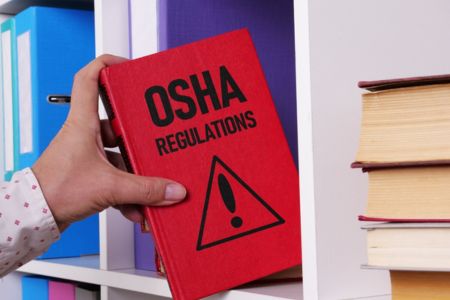Can OSHA shut down a business? Yes and no. The Occupational Safety and Health Administration (OSHA) has stop-work authority, but it cannot completely shut down your company without a court order. Understanding this subtle difference is important to protect your organization from fines and OSHA violations penalties.
OSHA was created to protect workers by enforcing safety standards. Usually, the administration accomplishes this goal by conducting audits and issuing citations to address any violations. If inspectors uncover severe breaches of workplace safety that put your employees or the general public at risk, they can issue a stop-work order.
Your company won’t be “shut down” per se. However, you must stop any work on the premises where the safety violation was discovered until you remedy the issue. You can resume operations once you’ve fixed the problem and OSHA has verified that you have implemented a viable remedy.
Both stop-work orders and court-ordered shutdowns can be detrimental to your company and its bottom line. You may also suffer lasting reputational damage and a loss of employee trust. Here’s a closer look at the shutdown process so that you can protect your workers and organization. We will answer the question: Can Osha shut a company down?
Table of Contents
Legal Framework for OSHA Shutdowns
The Occupational Safety and Health Administration was created under the Williams-Steiger Occupational Safety and Health Act of 1970. Section 13(a) of the law allows OSHA officials to address “imminent dangers.”
These situations are defined as practices or conditions that meet the following criteria:
- The conditions create a danger
- That danger is reasonably expected to cause serious physical injury or death
- The death or injury is imminent
- The danger cannot be eliminated through normal enforcement procedures
Simply put, inspectors can classify an issue as an imminent danger if it might cause serious harm before resolving it through normal protocols, such as issuing citations or receiving court orders.
OSHA can issue an Imminent Danger Notice. The subject business must immediately remove all workers from the area and fix the situation before they can resume work.
The act also provides a framework for how your business can comply with safety standards. It outlines the types of violations that can lead to enforcement actions, which range from minor infractions to hazardous working conditions. Minor violations will not warrant an Imminent Danger Notice, but more severe issues, such as a toxic chemical leak, might.
OSHA’s Shutdown Authority and Criteria
OSHA officials can independently issue an Imminent Danger Notice and a stop-work order. Inspectors could force you to stop operations immediately to prevent further harm. Once you remedy the problem and provide proof of the corrective action, OSHA can lift the notice, allowing your team to get back to work.
The act provides an additional mechanism for stop work authority to osha but is more far-reaching and requires a court order. If a company exhibits a pattern of non-compliance and continuously creates or ignores dangerous working conditions that may pose imminent harm to employees, OSHA officials can ask the courts to issue a shutdown notice.
Inspectors may also seek court intervention if they visit a job site and discover several egregious violations that are difficult or time-consuming to correct. The court order will prohibit the business from resuming any operations at that facility until it meets all requirements set forth by the judge.
The criteria OSHA uses to determine whether a shutdown is necessary include:
- The severity of the violation.
- The potential for harm.
- The company’s past safety record.
Explore OSHA’s website for additional details about how officials determine whether a shutdown is necessary.
The Shutdown Process
The student process typically begins with an audit or safety inspection. OSHA personnel visit a facility and thoroughly examine all areas of concern, including fueling stations, chemical storage areas, production lines, etc. Inspectors often show up unannounced to obtain a more objective view of a company’s day-to-day practices.
If the inspectors discover any violations, they can issue citations and require your business to fix them. Minor violations may include a grace period where you can avoid fines by remedying any issues within a specified time frame. More serious violations may carry an immediate fine.
OSHA auditors are not quick to issue Imminent Danger Notices. They only use these tools when severe violations are present and when there’s a legitimate risk to life or limb. If any such violations are discovered, inspectors may force your business to evacuate the area in question and stop any work in that facility or building.
The Imminent Danger Notice provides OSHA with a temporary solution for preventing worker injuries while they explore more permanent options, such as court orders or permanent repairs. Most of the time, employers will have an opportunity to fix the problem and will not face a court-ordered shutdown.
However, companies with multiple serious violations or a long history of negligence may be at a greater risk of shutdown. That’s why your business needs a robust compliance team that focuses on meeting OSHA standards. Here’s a closer look at the shutdown process so you can proactively mitigate the risk of a major violation:
1. Inspection and Citation Issuance
OSHA violations, penalties, and citations are critical components of the shutdown process. Inspectors respond to workplaces as part of routine evaluations in high-risk industries. They may also show up to a business following an accident or complaint.
The inspection process involves thoroughly assessing the work environment to ensure compliance with OSHA’s safety standards. Inspectors look for hazards such as unsafe machinery, lack of personal protective equipment, or improper handling of dangerous materials.
If inspectors find violations, they can issue citations detailing the specific safety issues that must be corrected. These citations can range from minor violations requiring quick fixes to more serious problems requiring immediate action.
Citations don’t automatically lead to a shutdown. However, repeated violations or egregious offenses can.
2. Imminent Danger and Cease Operation Orders
OSHA inspectors have the authority to issue an Imminent Danger Notice if they discover a situation that poses an immediate threat and is the most immediate and severe action they can take against your business. It’s reserved for extreme situations that increase the likelihood of death or serious injury.
Numerous scenarios can present an imminent danger. A lack of scaffolding for workers operating at a high elevation or a toxic chemical leak are just a couple of examples.
OSHA inspectors will notify you of an imminent danger and order you to shut down operations in that area immediately. They can also ask a judge to issue a cease-operation order, which will take longer to resolve. It’s best to address any imminent danger notices immediately and comply with OSHA requests so you can solve the problem as efficiently as possible.
3. Appeals and Contesting Orders
You can appeal if a court order has shut your company down. Contesting OSHA’s shutdown or citations can be a lengthy process, but it may be worthwhile if you believe the violations are unjustified.
Keep in mind that your business will remain closed while a shutdown order is active. If you do choose to contest the order, it’s important to consult with an occupational safety attorney. They can help you explore various options, such as requesting a stay of enforcement, which might allow you to resume some operations while you navigate the legal process.
Appealing and contesting OSHA orders definitely isn’t the preferred route. Court proceedings can take months to navigate and may cost tens of thousands in attorney’s fees. Make sure you have a strong case before contesting citations or shutdown orders.
4. Resolving Violations and Ensuring Compliance
Your top priority should be fixing the violation so you can get back to work. You’ll typically need to make major changes to the workplace, such as repairing equipment or providing additional employee training.
The sooner you address the violations, the better your odds of returning to work quickly. Don’t just fix the immediate hazard. You need to figure out what went wrong and how to prevent similar problems from emerging.
Proactive compliance inspections are among your best tools for preventing additional run-ins with OSHA. Alpha-Omega Training and Compliance (AOTC) provides compliance solutions that will help you mitigate the shutdown risks and keep your team safe. Our consultants offer on-site services and specialize in maintaining a state of compliance. We will make sure you are audit-ready.
Preparing for an OSHA Inspection
Don’t wait until an OSHA inspector arrives to consider whether you’ve got your workplace in order. Stay ahead of occupational health and safety regulations by teaming up with AOTC.
Our team of on-site compliance experts will take the hassle out of meeting federal safety regulations while also creating a great work environment for your staff. Contact AOTC today and schedule a consultation.


